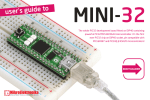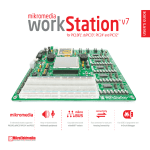Download GAMING Shield User Manual
Transcript
to GAMING shield Gaming shield is an extension board for your mikromedia that provides you with standard gaming buttons and audio speakers, so you can build and play your favorite arcade games. mikrome ia user's guide TO OUR VALUED CUSTOMERS I want to express my thanks to you for being interested in our products and for having confidence in Mikroelektronika. The primary aim of our company is to design and produce high quality electronic products and to constantly improve the performance thereof in order to better suit your needs. Nebojsa Matic General Manager The Microchip, Atmel, NXP and CYPRESS name, logo and products names are trademarks of Microchip, Atmel, NXP and CYPRESS Inc. in the U.S.A and other countries. Table of Contents Introduction to mikromedia GAMING shield 4 Mikromedia compatibility 5 Key Features 6 System Specification 7 1. Soldering stacking headers 8 2. Connecting to mikromedias 10 3. Connecting to other shields 11 4. Control Buttons and signal LEDs 12 5. Audio module 14 6. Gaming pinout on supported mikromedia boards 16 Gaming pinout on mikromedia for PIC18FJ 16 Gaming pinout on mikromedia for dsPIC33 17 Gaming pinouton mikromedia for XMEGA 18 7. Dimensions Page 3 19 ING Introduction to mikromedia GAM mikromedia GAMING shield is an extension board pin-compatible with several mikromedia boards from mikroElektronika that enables users to provide button controls and audio interface to your base mikromedia board, which is specially suitable for creating your own gaming console. GAMING Shield comes with convenient stacking connectors, so you can easily connect not only mikromedia, but other shields as well, such as Battery boost shield. It’s carefully designed to fit perfectly into anyone’s hands, and it has convenient holders which provide great stability when board is connected to mikromedia. Page 4 shield Mikromedia compatibility mikromedia for XMEGA mikromedia for dsPIC33 mikromedia for PIC18FJ Board is compatible with mikromedia for PIC18FJ v105, mikromedia for dsPIC33 v105 & v106 and mikromedia for XMEGA v110. All of the mentioned boards can exploit the full potential of the Gaming Shield, including buttons, signal LEDs and audio speakers. Page 5 Key Features 01 01 Top connections pads 03 02 02 Left Audio Channel amplifier circuit 03 Right Audio Channel amplifier circuit 04 Bottom connections pads 06 04 05 Left Speaker 06 Right Speaker 11 05 07 Navigation Joystick 08 Action Joystick 09 Reset Button 09 08 07 10 10 Start Button 11 Indicator LEDs 12 Left hand grip 13 Right hand grip 12 Page 6 13 System Specification power supply Over a USB cable (5V DC) power consumption 50mA in idle state (when on-board modules are off) board dimensions 15.2 x 15.1cm (5.98’’ x 5.94’’) weight ~74g (0.16 lbs) Page 7 1. Soldering stacking headers Figure 1-1: Positioning the stacking headers Before putting your mikromedia board on the Gaming shield, it is neccessary to solder 1x26 stacking headers to the shield. Stacking connectors come in the package with the board. It is also necessary to solder standard headers to your target mikromedia board. Depending on whether you soldered male or female headers to the mikromedia, you should position the stacking headers on the Gaming shield accordingly, so they can be connected together in a male-female (or female-male) pattern. Page 8 Figure 1-2: Correctly soldered stacking connectors on the back side with just enough soldering wire used When soldering the stacking headers, make sure not to put too much soldering wire on the pins, because you won’t be able to stack the desired shields correctly. Page 9 2. Connecting to mikromedias Once you have soldered the stacking headers, you can connect your mikromedia to the gaming shield. Make sure to connect the boards so that the shapes of mikromedia and top of the gaming shields are aligned. Figure 2-1: mikromedia board correctly placed on the gaming shield Page 10 3. Connecting to other shields When front side is connected with mikromedia, the rear side of the board can be used for stacking other mikromedia shields, such as the Battery Boost shield. Make sure to solder the appropriate headers to this addon shield, and make sure to match the board outlines when connecting them together. Figure 3-1: Battery Boost shield correctly placed on the gaming shield Page 11 4. Control Buttons and signal LEDs mikromedia Gaming shield provides standard button controls required in most arcade games. There are two sections of buttons for standard gaming functions: steering (left, right, up, down), actions (triangle, square, x, and circle), but we also added Start and Reset buttons. Board features four signal LEDs which can be used as indicators of game status, or other activities. Figure 4-1: Buttons and indicator LEDs are convenient for gameplay Page 12 VCC-5V VCC-3.3 VCC-3.3 R3 4K7 R2 4K7 R1 4K7 R0 4K7 LD3 RED LD2 RED LD1 RED LD0 RED LED-0 LED-1 LED-2 LED-3 T1 T3 VCC-3.3 VCC-3.3 L R JOY1-L JOY1-U JOY1-D JOY1-R JOY2-L JOY2-U JOY2-D JOY2-R START RST S1X26 VCC-3.3 T5 T2 JOY1-U JOY2-U JOY1-L JOY2-R JOY1-R JOY2-L JOY1-D JOY2-D T6 T8 T4 T7 R16 100K R15 100K R14 100K R13 100K R17 100K R9 100K R18 100K R19 100K R20 100K T9 T10 START R21 100K Figure 4-2: Schematics of button and LED connections Page 13 VCC-3.3 S1X26 5. Audio module Figure 5-1: LM4864 audio amplifier circuit Board is equipped with two LM4864 300mW audio power amplifiers, which are connected one to each speakers, thus making a stereo audio system. Left and right audio signals are brought to the board directly from the mikromedia board via two connections pins. Page 14 U2 C1 100nF E1 10uF R8 LEFT 20K C2 100nF SHUTDOWN VO2 BYPASS GND +IN VDD -IN VO1 SP1+ SP1 + VCC-3.3 C5 VCC-3.3 SP1- - 100nF EMB3008A LM4864 R6 75K U3 C3 100nF E2 10uF R5 RIGHT 20K C4 100nF SHUTDOWN VO2 BYPASS GND +IN VDD -IN VO1 SP2+ SP2 + C6 VCC-3.3 SP2- EMB3008A LM4864 R7 75K Figure 5-2: Left and right audio amplifier circuit schematics Page 15 VCC-3.3 100nF Gaming pinout on mikromedia for PIC18FJ NC GND NC NC NC NC NC NC NC LD0 LD1 LEDS LD2 LD3 NC NOTE: NC Pins that are not NC connected (NC) to NC the gaming shield NC NC can be used on the NC NC other side of the stacking headers NC NC with other shields NC 3.3V GND 5V GND RA2 RA3 RA5 RF2 RF5 RF6 RH4 RB0 RB1 RB2 RB3 RJ0 RJ1 RJ2 RJ3 RJ4 RJ5 RC0 RA4 RC3 RC4 RC5 3.3V GND RST GND L R RC2 RE6 RE5 RB4 RC1 RE2 RE1 RE0 RG0 RE4 RE3 RE7 RB6 RB7 RG2 RG1 RC7 RC6 RD6 RD5 3.3V GND Gaming shield functions Reset pin GND left ch. audio out right ch. NC NC NC NC NC NC NC LEFT UP JOYSTICK 1 DOWN RIGHT SQUARE TRIANGLE JOYSTICK 2 X CIRCLE START NC NC NC NC 3.3V GND Gaming shield function Page 16 Gaming pinout on mikromedia for dsPIC33 NC GND NC NC NC NC NC NC NC LD0 LD1 LEDS LD2 LD3 NC NOTE: NC Pins that are not NC connected (NC) to NC the gaming shield NC NC can be used on the NC NC other side of the NC stacking headers NC with other shields NC 3.3V GND 5V GND RB1 RB2 RB3 RB4 RB5 RB8 RB9 RA12 RA13 RA14 RA15 RA2 RA3 RF6 RF7 RF8 RG15 RA1 RA0 RG6 RG7 RG8 3.3V GND RST GND L R RD0 RD1 RD2 RD3 RD4 RD5 RD8 RD9 RD14 RD15 RD6 RD7 RA9 RA10 RF0 RF1 RF2 RF3 RG2 RG3 3.3V GND Gaming shield functions Reset pin GND left ch. audio out right ch. NC NC NC NC NC NC NC LEFT UP JOYSTICK 1 DOWN RIGHT SQUARE TRIANGLE JOYSTICK 2 X CIRCLE START NC NC NC NC 3.3V GND Gaming shield function Page 17 Gaming pinout on mikromedia for XMEGA NC GND NC NC NC NC NC NC NC LD0 LD1 LEDS LD2 LD3 NC NOTE: NC Pins that are not NC connected (NC) to NC the gaming shield NC NC can be used on the NC NC other side of the NC stacking headers NC with other shields NC 3.3V GND 5V GND PB1 PB2 PB3 PA4 PA5 PA6 PA7 PH0 PH1 PH2 PH3 PE1 PE0 PC7 PC6 PC5 PH7 PC4 PD4 PD7 PD6 PD5 3.3V GND RST GND L R PC0 PC1 PC2 PC3 PF0 PF1 PE4 PJ7 PR0 PR1 PE2 PE3 PE6 PE7 PF6 PF7 PD2 PG3 PD1 PD0 3.3V GND Gaming shield functions Reset pin GND left ch. audio out right ch. NC NC NC NC NC NC NC LEFT UP JOYSTICK 1 DOWN RIGHT SQUARE TRIANGLE JOYSTICK 2 X CIRCLE START NC NC NC NC 3.3V GND Gaming shield function Page 18 37.9 mm (1.50") 69.00 mm (2.72") 33.00 mm (1.30") 151.00 mm (5.95") 36.00 mm (1.42") 31.00 mm (1.22") 7. Dimensions 80.90 mm (3.19") 3.00mm (0.12”) 152.00 mm (6.00") Page 19 Notes: Page 20 Notes: Page 21 Notes: Page 22 DISCLAIMER All the products owned by MikroElektronika are protected by copyright law and international copyright treaty. Therefore, this manual is to be treated as any other copyright material. No part of this manual, including product and software described herein, may be reproduced, stored in a retrieval system, translated or transmitted in any form or by any means, without the prior written permission of MikroElektronika. The manual PDF edition can be printed for private or local use, but not for distribution. Any modification of this manual is prohibited. MikroElektronika provides this manual ‘as is’ without warranty of any kind, either expressed or implied, including, but not limited to, the implied warranties or conditions of merchantability or fitness for a particular purpose. MikroElektronika shall assume no responsibility or liability for any errors, omissions and inaccuracies that may appear in this manual. In no event shall MikroElektronika, its directors, officers, employees or distributors be liable for any indirect, specific, incidental or consequential damages (including damages for loss of business profits and business information, business interruption or any other pecuniary loss) arising out of the use of this manual or product, even if MikroElektronika has been advised of the possibility of such damages. MikroElektronika reserves the right to change information contained in this manual at any time without prior notice, if necessary. HIGH RISK ACTIVITIES The products of MikroElektronika are not fault – tolerant nor designed, manufactured or intended for use or resale as on – line control equipment in hazardous environments requiring fail – safe performance, such as in the operation of nuclear facilities, aircraft navigation or communication systems, air traffic control, direct life support machines or weapons systems in which the failure of Software could lead directly to death, personal injury or severe physical or environmental damage (‘High Risk Activities’). MikroElektronika and its suppliers specifically disclaim any expressed or implied warranty of fitness for High Risk Activities. TRADEMARKS The Mikroelektronika name and logo, the Mikroelektronika logo, mikroC, mikroC PRO, mikroBasic, mikroBasic PRO, mikroPascal, mikroPascal PRO, AVRflash, PICflash, dsPICprog, 18FJprog, PSOCprog, AVRprog, 8051prog, ARMflash, EasyPIC5, EasyPIC6, BigPIC5, BigPIC6, dsPIC PRO4, Easy8051B, EasyARM, EasyAVR5, EasyAVR6, BigAVR2, EasydsPIC4A, EasyPSoC4, EasyVR Stamp LV18FJ, LV24-33A, LV32MX, PIC32MX4 MultiMedia Board, PICPLC16, PICPLC8 PICPLC4, SmartGSM/GPRS, UNI-DS are trademarks of Mikroelektronika. All other trademarks mentioned herein are property of their respective companies. All other product and corporate names appearing in this manual may or may not be registered trademarks or copyrights of their respective companies, and are only used for identification or explanation and to the owners’ benefit, with no intent to infringe. © Mikroelektronika™, 2011, All Rights Reserved. If you want to learn more about our products, please visit our website at www.mikroe.com If you are experiencing some problems with any of our products or just need additional information, please place your ticket at www.mikroe.com/en/support If you have any questions, comments or business proposals, do not hesitate to contact us at [email protected]




































